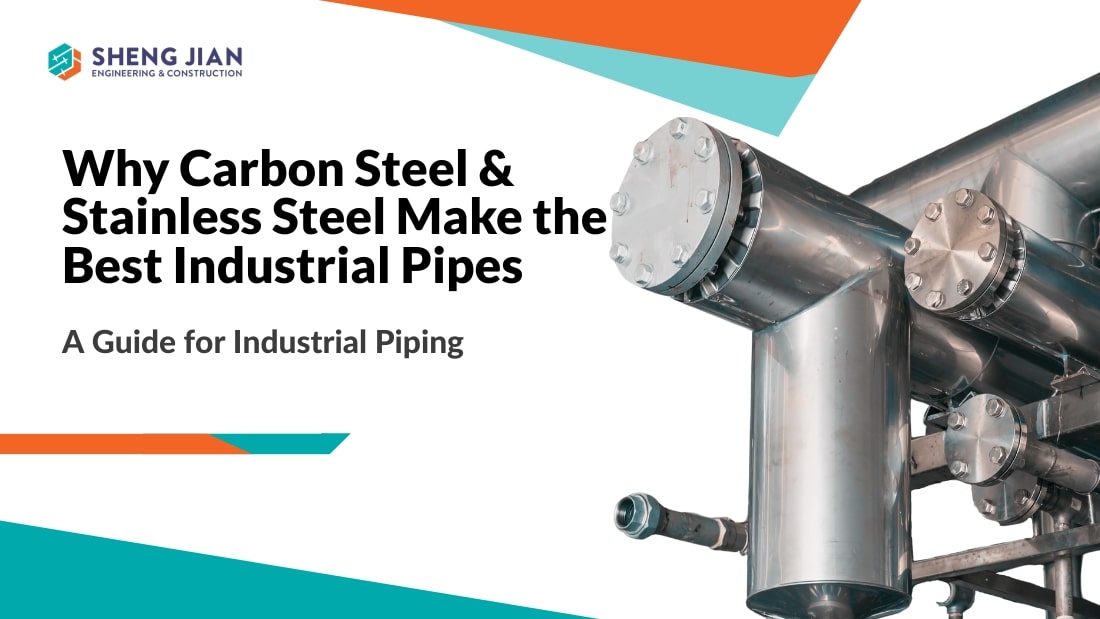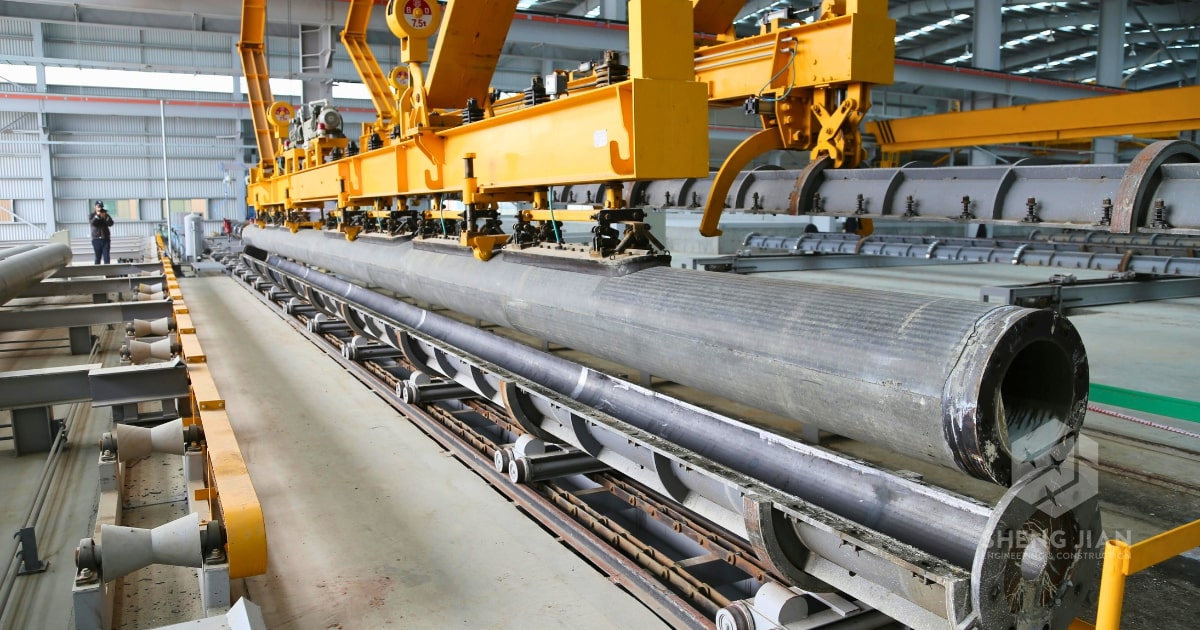
23 Jul Why Carbon Steel & Stainless Steel Shine in Industrial Piping
When it comes to industrial piping, two materials consistently lead the way: carbon steel and stainless steel. These metals are widely used in industries ranging from oil and gas to food processing and heavy manufacturing, and for good reason. Their unique properties offer a balance of strength, durability, and resistance that few other materials can match.
If you’re unsure whether to choose between carbon steel and stainless steel pipes, this guide will walk you through their characteristics, differences, and why both remain top choices for many piping suppliers around the world.

Carbon steel and stainless steel’s strong properties make them ideal for industrial piping.
What makes a good industrial pipe material?
Before comparing specific materials, it’s helpful to understand what qualities make a pipe reliable for industrial use and conditions.
Key qualities include:
- Pressure, temperature & corrosion resistance – Handles tough environments without failing.
- Durability & low maintenance – Minimises downtime and repair costs.
- Cost-effectiveness – Balances upfront cost with long-term value.
- Fabrication-friendly – Easy to cut, weld, or customise on-site.
- Standards compliance – Meets ASTM, API, or ISO requirements for safety and performance.
Carbon steel vs stainless steel: How they compare
In piping applications, carbon steel and stainless steel have their respective properties that make them well-suited to different applications.
Carbon steel pipes
Strong, cost-effective, and reliable, carbon steel pipes are composed mainly of iron and carbon, often with trace amounts of elements like manganese or silicon to enhance their properties.
These pipes are typically manufactured through hot-rolled or cold-drawn processes and are available in various grades, including ASTM A106 and A53, which are widely used for high-temperature and pressure applications.
Carbon steel’s simple composition brings with it several benefits:
High strength for heavy-duty applications
Carbon steel has excellent tensile strength, making it a preferred choice for industrial machinery and high-pressure fluid transportation systems such as gas pipelines, steam lines, and structural frameworks.
Versatility in structural and mechanical roles
Carbon steel pipes are widely used in various industrial applications like load-bearing frameworks, mechanical supports, boiler systems, and industrial piping networks. Their weldability and machinability make them a practical option for most fabrication needs.
Cost-efficiency for large-scale builds
Compared to stainless steel, carbon steel is more affordable. For projects requiring high volume without compromising structural integrity, carbon steel pipes offer exceptional value.
However, carbon steel pipes are not infallible. They are prone to corrosion unless coated or insulated. That’s why pipe insulation or protective linings are commonly used in projects that involve moisture or corrosive environments.
Stainless steel pipes
Stainless steel pipes are made from a mix of iron, carbon, and at least 10.5% chromium — a key ingredient that makes them corrosion-resistant. Other elements like nickel and molybdenum are often added to boost strength and durability even further.
These pipes are typically produced as either seamless or welded types and are available in popular grades like 304 and 316, each suited to different industrial needs. As stainless steel can withstand high temperatures, is rust-resistant, and stays strong under pressure, these pipes are ideal for both general and specialised industrial applications.
High corrosion resistance
The chromium in stainless steel forms a passive layer on the pipe surface, shielding it from moisture and chemical exposure. This makes it ideal for industries like pharmaceuticals, F&B, or marine environments where corrosion is a major concern.
Durable with a long service life
Even without coatings, stainless steel pipes can last for decades with minimal wear or degradation, especially in cleanrooms, medical, or chemical settings.
Aesthetic and hygienic
Stainless steel’s smooth, non-porous surface makes it easy to clean and sterilise, reducing the risk of bacterial buildup. This makes it ideal for sectors like F&B and pharmaceuticals, where hygiene compliance is critical. And fitting for its name, stainless steel pipes offer a polished, professional look.
The trade-off, however, is cost. Stainless steel pipes are generally more expensive upfront, but their minimal maintenance needs and long lifespan often result in better value over time, particularly in high-demand or highly regulated industries.
Carbon steel vs stainless steel pipes: Which to choose?
Carbon steel and stainless steel shine under different conditions, so the right pipe material choice comes down to finding what suits your project’s needs best.
Here’s a quick comparison to help guide your decision:
| Factor | Carbon Steel Pipe | Stainless Steel Pipe |
|---|---|---|
| Project environment | May rust in humid or corrosive environments without protection | Naturally resistant to corrosion and ideal for moist or chemical settings |
| Pressure & temperature | Excellent strength for high-pressure, high-temperature systems | Stable under temperature swings, but not as strong as carbon steel |
| Lifespan & maintenance | 10–20 years with coating and upkeep | 20–30 years or more with minimal maintenance |
| Budget | Lower upfront cost, higher long-term maintenance | Higher upfront, lower long-term costs due to durability |
| Insulation/coating | Often required to prevent corrosion | Generally not required |
By understanding where each material excels, you can select a piping solution that balances cost, durability, and performance for your environment.
Leverage carbon steel and stainless steel for your industrial piping with SJEC
Carbon steel and stainless steel pipes offer reliable performance across many industrial applications. Their respective strengths, whether in cost, corrosion resistance, strength, or hygiene, make them some of the most commonly used industrial piping materials today.
If you have a piping project underway, it’s well worth it to make use of quality carbon steel and stainless steel pipes for your system, especially when you source from a trusted piping supplier in Malaysia, like SJEC!
At SJEC, we provide industrial pipework solutions built upon our expertise in carbon steel and stainless steel pipe fabrication, insulation, and on-site installation. With us, you can trust in reliable piping systems constructed with the lasting strength you need. Contact our team today to see what we can do for your industrial piping needs!
FAQ
Is carbon steel stronger than mild steel?
Yes, carbon steel is generally stronger than mild steel. Mild steel contains a lower percentage of carbon (typically around 0.05–0.25%), making it softer, more ductile, and easier to weld. In contrast, carbon steel has a higher carbon content, which increases its tensile strength and hardness, making it more suitable for heavy-duty industrial applications, like piping.
However, the trade-off is that carbon steel is also more brittle and less flexible.
Which is better — 304 or 316 stainless steel?
It depends. 304 stainless steel is the most commonly used grade, offering excellent corrosion resistance and good strength, ideal for indoor or dry environments. In contrast, 316 stainless steel contains added molybdenum, which makes it more resistant to chlorides and harsh chemicals.
If you’re working in marine, chemical, or high-salinity environments, 316 is usually the better choice despite being more expensive.
Which grade of carbon steel is best?
The best grade depends on the project requirements. For most industrial piping and structural applications, ASTM A106 Grade B and ASTM A53 Grade B are popular choices due to their strength and versatility. For high-pressure or oil and gas applications, API 5L grades like X42 or X52 are commonly used.

